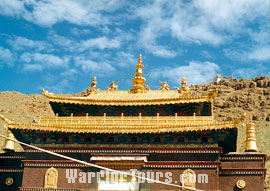Shigatse Introduction

Shigatse is located between 29 north altitude and 88 east longitude with an elevation of 3800 meters; at the confluence of Nyangchu and Yarlung Tsangbo River about 250 kilometers to the west of Lhasa. Its neighboring areas include Qinghai Province, Sichuan Province, Yunnan Province and Xinjiang Uygur Autonomous Region.
![]() Shigatse Facts
Shigatse Facts
![]() Population: 70,000
Population: 70,000
![]() Nationalities: Han, Hui and Tibetan
Nationalities: Han, Hui and Tibetan
![]() History: a history of more than 5 centuries; formerly called Tsang and ever rivalled Lhasa
History: a history of more than 5 centuries; formerly called Tsang and ever rivalled Lhasa
![]() Climatic Features: moderate climate with plenty of sunshine; frost-free period of 160 days.
Climatic Features: moderate climate with plenty of sunshine; frost-free period of 160 days.
![]() Average Temperature: 6 ?
Average Temperature: 6 ?
![]() Rainfall: average annual of 300 to 450 mm.
Rainfall: average annual of 300 to 450 mm.
Sakya, meaning 'gray soil', is the first monastery of Sakyapa Sect of Tibetan Buddhism. Located 130 kilometers (80 miles) southwest of Shigatse, Sakya Monastery was divided into Northern Monastery and Southern Monastery. The Northern Monastery was built in 1073 by the founder of the Sakyapa, Khon Konchog Gyalpo. But now, there is nothing left but ruins.
The Southern Monastery was built by the fifth Sakya Throne Holder, Phakpa, in 1268. It is a square castled construction, covering an area of more than 14,700 square meters (about 3.63 acres). As the religious center as well as the political center of Tibet during the reign of Sakyapa Sect, the monastery holds city walls, blockhouses, and even a moat outside the wall. The walls were painted in red, white and grey strips, which represent Manjushri, Avalokiteshvara and Vajrapani separately.

The Main Chanting Hall, or Lakhang Chenmo, is the central construction of Sakya Monastery. It is supported by 40 pillars and four bigger ones are most outstanding. It is said that these four pillars were presents from the Yuan Emperor, a wild yak, a male tiger and Nereus. All the stories are clearly depicted by the murals on the wall.
The sculptures of Sakyamuni and the fifth Sakya Throne Holder are enshrined in the hall. Stupa-tombs of each Sakya Throne Holders are also situated here. Murals, most of them were painted during the Yuan Dynasty (1271-1368), are still well preserved in the monastery. Besides, about 40 thousands volumes of sutras are collected in the monastery, about half of which are hand-written copies during the Yuan and Ming Dynasty (1368-1644). All these precious culture relics give Sakya Monastery a title: 'the Second Dunhuang'.
| Admission Fee: | CNY 45 |

![]() Travel Tips
Travel Tips
![]() Local Highlights: Various Tibetan festivities and Buddhist activities.
Local Highlights: Various Tibetan festivities and Buddhist activities.
![]() Shigatse Gold, Silver and Copper Crafts Factory: At the end of the 18th century, the seventh Panchen Lama invited Nepal craftsmen to make golden and silver vessels for Tashihunpo Monastery. Since then, the workshop came into being and has kept operating for more than 150 years. It changed to the gold, silver and copper factory after 1959, but their traditional techniques were kept down. Products of this factory are very popular among the monasteries in Tibet, Gansu and Qinghai. What's more, the golden and silver decorations in the stupa of the Tenth Panchen Lama were also designed and made in this factory.
Shigatse Gold, Silver and Copper Crafts Factory: At the end of the 18th century, the seventh Panchen Lama invited Nepal craftsmen to make golden and silver vessels for Tashihunpo Monastery. Since then, the workshop came into being and has kept operating for more than 150 years. It changed to the gold, silver and copper factory after 1959, but their traditional techniques were kept down. Products of this factory are very popular among the monasteries in Tibet, Gansu and Qinghai. What's more, the golden and silver decorations in the stupa of the Tenth Panchen Lama were also designed and made in this factory.


